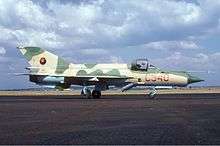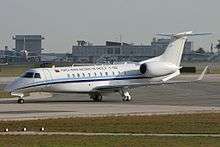National Air Force of Angola
The National Air Force of Angola or FANA (Portuguese: Força Aérea Nacional de Angola) is the air branch of the Armed Forces of Angola.
| National Air Force of Angola | |
|---|---|
| Força Aérea Nacional de Angola | |
 Angolan Air Force emblem | |
| Founded | 21 January 1976 |
| Country | Angola |
| Branch | Air force |
| Role | Aerial warfare |
| Size | 285–348 aircraft |
| Part of | Angolan Armed Forces |
| General command | Luanda |
| Nickname(s) | FAN or FANA |
| Engagements | Angolan Civil War |
| Commanders | |
| General | Francisco Lopes Gonçalves Afonso |
| Insignia | |
| Roundel |  |
| Aircraft flown | |
| Attack | Su-25, Su-22 |
| Fighter | Su-27, MiG-23, MiG-21 |
| Helicopter | Mi-8 |
| Attack helicopter | Mi-24/35 |
| Patrol | Fokker F27, EMB-110, C.212 |
| Trainer | Yak-11, PC-7, Embraer EMB 312 Tucano |
| Transport | C-130 Hercules, An-12, An-26 |
With an inventory of more than 300 aircraft, FANA is (on paper) one of the largest air forces of Africa.
History
Angola became independent from Portugal on 11 November 1975. However, the foundations for the establishment of the air force were laid before independence when members of the then Flying Club of Angola (Aeroclube de Angola) were assembled at Luanda in October 1975.[1] These people and aircraft left behind by the Portuguese Air Force formed the basis for the air transport branch of the force.
The force was formally established on 21 January 1976 as the People's Air Force of Angola / Air and Antiaircraft Defense or FAPA/DAA (Força Aérea Popular de Angola / Defesa Aérea e Antiaérea). Its first batch of Soviet MiG fighter aircraft was delivered in mid-December 1975.[1] The FAPA/DAA fought several battles with South African Air Force aircraft in November 1981, October 1982, and twice in September 1987.[2]
Circa 1983-85, in order to enhance MPLA's combat capacity, Romania sent 150 flight instructors and other aviation personnel, who contributed to the establishment of an Angolan Military Aviation School.
The FANA has bases at Luanda, Catumbela, Belas, Luena, Kuito, Lubango and Moçâmedes. The World Factbook, produced by the CIA, reported that by 2007 the name of the force had changed to "National Air Force".[3]
Most of the inventory is out of service, and refers to historical equipment delivered along the years. FAN has many bases – most of them, former Portuguese Air Force bases and other courtesy of the cold war – but few airplanes that actually fly. The main body of the active air force is made of transport/cargo planes, used for moving supplies, equipment and personnel between parts of the country.
Organization
The National Air Force of Angola is headed by the Chief of Staff of the FANA (Chefe do Estado-Maior da FANA). The Chief of Staff of the FANA is a General directly subordinate to the Chief of the General Staff of the Armed Forces of Angola.
FANA follows a Russian/ex-Soviet organizational model, with its air units being aviation regiments (regimentos de aviação), each one including several squadrons (esquadrões). To each of the six aviation regiments corresponds an air base. Besides the aviation regiments, there is also a Pilot Training School.
Its order of battle is:
- 25th Fighter Aviation Regiment (Kuito Air Base)
- 13th Fighter Squadron (Su-27 and Su-27UB)
- 12th Fighter Squadron (MiG-23ML and MiG-23UB)
- 11th Fighter Squadron (MiG-21bis, MiG-21M, MiG- 21F-13 and MiG-21U)
- 26th Fighter Aviation Regiment (Moçâmedes Air Base)
- 14th Fighter Squadron (Su-24MK)
- 16th Fighter Squadron (Su-25K and Su-25UBK)
- 15th Fighter Squadron (Su-22M-4K and Su-22UM-3K)
- 24th Training Regiment (Menongue Air Base)
- 8th Training Squadron (L-39ZA, EMB-312, PC-9 and PC-7)
- 9th Training Squadron (L-29 Delfin, MiG-15UTI, Yak-11 and PC-6B)
- 10th Training Squadron (Cessna 172 and Z-142C)
- 23rd Air Transportation Regiment (Luanda Air Base)
- 5th Light Transportation Squadron (An-2, An-12, An-24, An-26, An-28, An-32, An-72, An-74, F-27, C-212-300, C-212-200, BN- 2A-21 Commander Turbo, Do-27, Do-28C and Do-228)
- 6th Transportation Squadron (Il-76T, C-130K, Lockheed L-100-20 and Boeing 707)
- 7th Transportation Squadron (Boeing 707 and EMB-120)
- 21st Transportation Helicopter Regiment (Luena Air Base)
- 1st Helicopter Squadron (SA-315, IAR-316, SA-342m, AB-212 and SA-365m)
- 2nd Helicopter Squadron (Mi-8, Mi-17 and AS-532)
- 22nd Combat Helicopter Regiment (Huambo Air Base)
- 3rd Helicopter Squadron (Mi-25, Mi-35, AS-565AA, AS-565UA and SA-342m)
- 4th Helicopter Squadron (Mi-24, Mi-25 and Mi-35)
- Pilot Basic Training School (Lobito)
Aircraft
Current inventory



Accidents and incidents
On 14 September 2011, an Embraer EMB 120 Brasilia, operated by the Air Force, crashed just after takeoff from Nova Lisboa Airport,[10] killing 11 army officers (including three generals, among them Kalias Pedro) and six civilians.[11][12] The accident occurred at 11:30 am at the airport, with a military delegation on board the flight at Albano Machado Airport.[13]
References
- Cooper, Tom & Weinert, Peter (2010). African MiGs: Volume I: Angola to Ivory Coast. Harpia Publishing LLC. p. 17. ISBN 978-0-9825539-5-4.
- Cooper and Weinert 2010, 52, 54, 60.
- "Non official site with history of FAN" (in Portuguese). fanangola.webnode.pt. Archived from the original on 31 March 2012. Retrieved 21 August 2011.
- "World Air Forces 2020". Flightglobal Insight. 2020. Retrieved 16 January 2020.
- "World Air Forces 2001 pg. 35". flightglobal.com. Retrieved 10 February 2015.
- "World Air Forces 2001 pg. 35". flightglobal.com. Retrieved 10 February 2015.
- "Angolan Air Force embraer crash". .flightglobal.com. Retrieved 18 December 2014.
- International Institute for Strategic Studies; Hackett, James (ed.). The Military Balance 2016. London: Routledge. ISBN 1857435575.
- "World Air Forces 2002 pg. 35". flightglobal.com. Retrieved 21 March 2015.
- "Accident Description". Aviation Safety Network. 14 September 2011. Archived from the original on 24 September 2011. Retrieved 15 September 2011.
- "Angola: Huambo air force plane crash kills generals". BBC News. 15 September 2011. Archived from the original on 15 September 2011. Retrieved 15 March 2012.
- "Angola army says 17 killed in air crash". Dawn.com. 14 September 2011. Retrieved 15 September 2011.
- "17 Killed in Wednesday Air Force plane crash". Angola Press Agency. 15 September 2011. Archived from the original on 27 March 2012. Retrieved 15 September 2011.
Further reading
- Cooper, Tom & Weinert, Peter (2010). African MiGs: Volume I: Angola to Ivory Coast. Harpia Publishing LLC. ISBN 978-0-9825539-5-4.